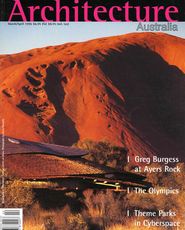Foundations of Identity: Building Early Sydney 1788-1822
By Peter Bridges.
Parramatta: A Town Caught In Time, 1870
By Shylie and Ken Brown with Carol Liston and Robert Irving.
Both published by Hale & Iremonger, hardbacks, $35 each.
Review by Anne Warr

John Purchase’s Riverside townhouses at Parramatta, 1879.
Peter Bridges’ book focuses on the first 34 years of the colony of New South Wales and he sections his detailed research into themes that question the values and characteristics of Australian society today. Shylie and Ken Brown’s book on Parramatta focuses on one year, 1870, and the messages that a collection of photographs can convey to us over 125 years.
Bridges’ themes include attitudes towards authority, the organisation of labour, how things got built, who had the power to get things done. Right from the beginning, there were battles between private and public interests, involving corruption, bribery and the desire for public enhancement at the expense of public good. Governors Phillip and Macquarie had strong interests in public architecture while Governors Grose and Paterson decided to advance the colony by giving out extensive grants to the military and their supporters for private enterprises.
Yet the chapter on the Female Factory places Macquarie’s great public building program in perspective by contrasting his failure to properly accommodate female convicts with his pursuit of pet projects such as churches at Sydney, Windsor and Liverpool, as well as Government House and its stables.
Bridges considers the treatment of women convicts—how did they contribute to the colony’s industry and how were they treated by the government? Unfortunately there is no chapter on the relationship between the colonists and the Kooris, although the foreword explains this as only being due to “scant official reporting of the extent of the destruction of an existing society”.
The title probably infers more about Australian identity than is actually delivered—but the text is readable and provoking from beginning to end (not just a dipping-in book). As Dr Lenore Coltheart says in her foreword: “This is a book about the past and for the future. throws down a challenge for more such work showing the influence of heritage in everyday life”.
Shylie and Ken Brown have responded to this challenge.
The format of their book is simple and clear: 106 photographs, one per page, with succinct captions, a map at the front showing the locations of the buildings in Parramatta and which are still standing, an introduction by historian Carol Liston and an architectural commentary by Robert Irving.
The photographs are from the J.K.S. Houison collection held by the Society of Australian Genealogists, which includes photographs by Henry Beaufoy Merlin, Charles Bayliss, Henry Burgin and Charles Tuke. Dr Andrew Houison, the first president of the Australian Historical Society, gave magic lantern shows in the 1890s, featuring photographic images of Parramatta and Sydney. After his death, more than 8000 lantern slides were given to the society. Shylie came across these in the mid 1980s while seeking display material for the Parramatta and District Hospital Society.
Most of the photographs in this book are by Henry Beaufoy Merlin, who came to Australia in 1849 at the age of 19. By 1869, his American and Australasian Photographic Company was photographing “almost every house in Melbourne and the other towns in Victoria”. He then headed north and in 1870 reported that his company had “just completed taking nearly 800 views of Parramatta”. Merlin would advertise in advance the dates of his building-by-building coverage of a targeted town and encourage people to stand outside their shops and houses to have their “complete and life-like portraits” included in the street scenes.
The commentary accompanying each photograph complements Merlin’s style by concentrating on the social history of the building and its occupants, leaving an architectural description to be covered by Robert Irving’s scholarly paper at the end of the book. For example, Plate 11 is described as showing “probably Nat Payten junior and family members grouped on the left, with hotel guests on the right and a handsome carriage centrally positioned on the driveway to complete the tableau“.
Merlin’s photographs are a social mapping exercise of the time. To take Lenore Coltheart’s challenge for “more such work showing the influence of heritage in everyday life” further, I’d like to see the heritage studies of our municipalities taking a more Merlin-like social perspective.
Anne Warr is manager of the heritage section at NSW Public Works and Services.
Technological Change and the City
Edited by Patrick Troy, published by The Federation Press, paperback, $35.
Review by David Week
This is potentially a timely book. Aimed at “government at all three levels, at the intelligent layman and at students of the city”, it looks at the interaction of technological change and urban form. It does so through nine articles by Australian academics on different aspects of this interaction.
The book does contain useful information. But too much of the text is polysyllabic generalisation and abstraction, which when translated into plain English expresses truisms or the obvious. There are not nearly enough specifics of present or potential urban patterns, and there are no diagrams.
This book is at best a generalised background briefing which presents no clear picture of what is critical in the current debate on urban form.
David Week is the director of Pacific Architecture, Sydney.
|
Transfiguring the Ordinary
Edited with an introduction by Leon van Schaik. Published by 38 South/Royal Melbourne Institute of Technology, paperback, $35.
Review by Stanislaus Fung
Transfiguring the Ordinary features the work of six graduates of RMIT’s M.Arch (by project) programme and is impressive as a body of work gathered under the visionary direction of Leon van Schaik. Though midway between a book and a collection of theses/projects in need of subeditorial polish (and pagination), it serves well to underline the importance of RMIT as our premier institution where prominent members of the architectural community develop ideas in an academic setting. Leon van Schaik’s introduction, ‘How Australian Is It?’, is a stimulating piece on Australianness, cities and the social production of space. Frantic undergraduates working on an assignment on Ian McDougall will ogle the famous Melburnian’s ‘The Autistic Ogler’ and raise their eyes towards their suburban ceilings in gratitude. Behold! They will be transfigured with a brand of facial charm, probably patented by Pierre et Gilles.
Stanislaus Fung is the lecturer in history and theories of architecture at the University of Adelaide.
Australian Cities: Issues, Strategies & Policies for Urban Australia in the 1990s
Edited by Patrick Troy, published by Cambridge University Press, paperback, $30. Review copy courtesy McGills Books, Brisbane and Melbourne.
Australian Cities: Continuity & Change
By Clive Forster, published by Oxford University Press, paperback, $22. Review copy courtesy McGills Books, Brisbane and Melbourne.
Review by Philip Thalis

Ian McDougall’s ‘The Autistic Ogler’, in Transfiguring the Ordinary
Talk to many architects about politics and planning and their frustrations become immediately apparent. Yet the interaction of those forces with our complex and evolving society is central to defining architecture’s role today. Architects, students and members of related disciplines need to be better informed and more ‘engaged’ to limit the further marginalisation of their roles in shaping our built environment.
Two recent books—both titled Australian Cities—add to the extensive literature on urban development and policy in Australia. For his book, subtitled Issues, Strategies and Policies for Urban Australia in the 1990s, Professor Patrick Troy has chosen the generally accessible format of a collection of essays; here grouped in three parts: ‘The Development and State of Australian Cities’, ‘Current Policies and Options’, and ‘Avenues for Development’. Contributors are gathered from around the country, although the heaviest concentration comes from Troy’s suburban enclave at the ANU’s Research School of the Social Sciences in Canberra.
Although the scope of the essays appears broad-ranging and pluralist, potential readers should be aware of the pervasive Troy editorial slant—anti-metropolitan, pro-decentralisation, DURD revisionist—a myopic idealisation of Arcadian suburbia as the mythic incarnation of Australia’s social aspirations.
Typical of the generation that took the town out of planning, Troy summarises the authors’ contributions in Part 1 as “ … all query the reversion to physical determinism …”, while elsewhere he miscategorises “ … postmodern experiments in urban design and planning”. In the meantime, architects and others outside the planning profession have long concluded that the failures of modern planning stem largely from the abandonment of the physical dimension in forming cities in favour of abstract regulation and policy.
Like Stretton, Troy belongs to a century-long tradition of advocates for the suburb. However, unlike the founders of the town planning movement around World War I, who attacked the ills of the 19th century city, Troy should confront the physical legacy of post-World War II planning policies which have generated our unchecked urban sprawl and profligate land use, ensuing environmental degradation and unsustainable agglomerations resulting from car dependence and chronic disinvestment in public transport.
In the face of these real challenges, Troy unconvincingly attacks urban consolidation initiatives and Brian Howe’s housing and Building Better Cities programmes. For example, the negative case of the NSW state government versus local Balmain planning wars is discussed instead of positive models of consolidation. Similarly, Better Cities is implicitly and explicitly criticised, despite evidence that it has been far more focused and relevant than DURD in the early 1970s.
The second book, subtitled Continuity and Change, is written by Clive Forster, senior lecturer in geography at Flinders University in South Australia. Although intended partly as a textbook for geography, urban planning and urban sociology students, it also covers the effects of economic restructuring, employment and housing distribution, policies for expanding cities, inequalities between suburbs and the question of locational advantage, as well as urban consolidation. As a succinct and straightforward examination of the state of affairs of Australian cities, Forster’s book could be usefully added to the reading lists for architecture and landscape students.
Urban designer Philip Thalis is on the masterplanning team for the Sydney Olympics.
|

















